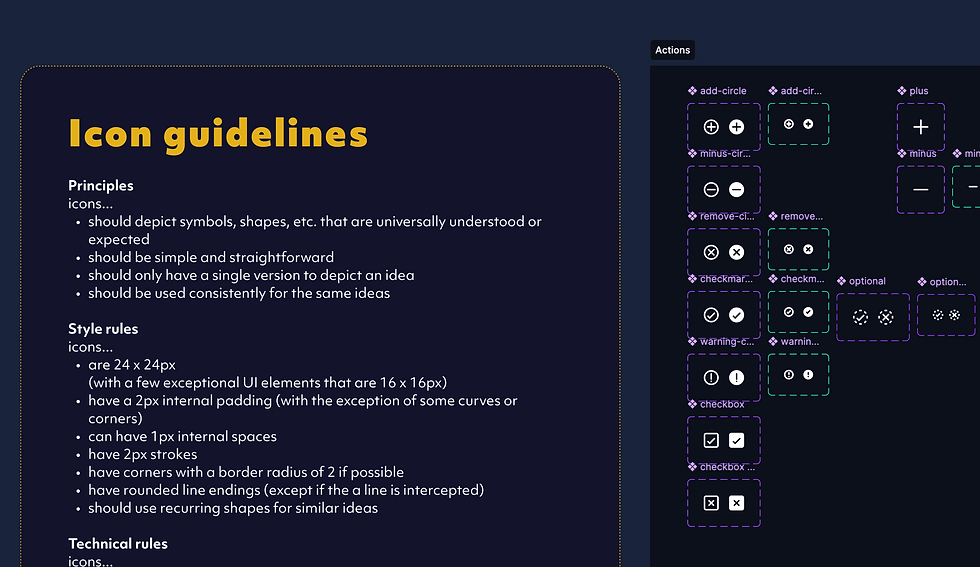Octo Design System
- Daniel Zoltan Aczél
.jpg/v1/fill/w_320,h_320/file.jpg)
- Oct 9
- 4 min read
Usually these case studies contain some kind of twist and relevation - how we came up with a new approach to design systems and failed many times, but learned from our failures and finally ended up with a better version or something -. But that's not really the case for the design system we built for Octomind.
We knew how to build a good design system, we designed it, we built it, it worked like a charm, end of story. Here are some details about it if you are into this kind of thing:
The Octo Design System Foundation
The foundation layer contained the following tokens:
colors
typography
effects
paddings and margins
Colors and Tokens
Our colors were very carefully designed not just to look good, but to be perfectly functioning as tokens.
The color tokens had two layers. Base tokens for the raw colors and functional tokens, this way they can easily updated in isolation if needed, but still only in one central place.
Some interesting mechanics that play well together:
every second layer token was using the same value base token as a reference for the same functionality. Example: text tokens are derived from value 20 tokens and background tokens are derived from value 80 tokens
every token with a value of 50 or less should be AA compliant with dark text and every token with greater or equal value are AA compliant with light text
every same value token has the same level of color contrast in accordance to different value tokens, therefore it is very easy to know which can be combined with which token to achieve certain accessibility standards
Therefore even if a developer randomly assigned a text style to a text on a randomly assigned background, it will always be readable in at least AA level of the WCAG accessibility standard! It was literally impossible to do less accessible UI than designed.

There were even more colors for graphs, gradients for hero items and some transparent tokens in the system as well with a similar logic as the base colors.
Hierarchy
The hierarchy of the elements in Octo Design System was also very precisely designed so its not only easy to use, but basically dictates usage to whoever is working with it.
Typographic styles, border radiuses, effects, margins and paddings, element sizing and so on could have 3 sizes: Large, Medium or Small. From here on the logic was simple:
on the body large value entities can go (large title, large card with a large border radius, etc...)
inside large elements go the medium elements
in medium elements go the small elements
nothing goes in small elements
These rules not only helped us create a hierarchy that makes sense to our users, but also prevented us from making unsatisfactory solutions:
we couldn't nest infinite elements in each other, therefore our UI remained simple with a maximum of 3 levels of objects
we couldn't fall into the trap of UI scale-shift, where the elements are just progressively growing or shrinking as the designs evolve
Once again it was impossible to design or develop something that didn't meet our predefined standards.

An additional visual eye-candy that I absolutely loved was that the size of border radiuses and their parent components' internal paddings were synchronized in a way that elements nested in each other always had the same centerpoint for the circular shape that defined their border radius (see octo-radius-small and octo-radius medium on the picture above). Not only this looked nice, but if something was nested in the wrong element, it was very easy to spot even for someone who is not so design-savvy.
Component Layer
Nothing extravagant here, our components followed the same sizing (L-M-S) and were hosted in Storybook where devs could try them out before using them.

Our next step was to create component-combinations or patterns that were commoly used groups of components.

Icons
Icos are mostly part of the Branding topic, but from a design system perspective an interesting quality of life feature we created was the automatic syncing of the icons from Figma to our repo without any manual work. Ok, a little manual work, there was a sync button in GitHub that you needed to press.
Of course this meant that whatever was in Figma got into the app directly - we had a some mechanics to avoid large failures, but a lot of discpline was needed from the design side, therefore we wrote down some rules.

Summary
Of course we had to redo a couple of things, tweak it on the go, but not that much. We did a colour-overhaul once, that was the biggest change and even that was quite easy because we followed best practices. Our agile coach did it on the side because she felt like coding a bit. So in a nutshell, design systems are not supposed to be painful if you have a plan and everybody is on board from the beginning.
Comments